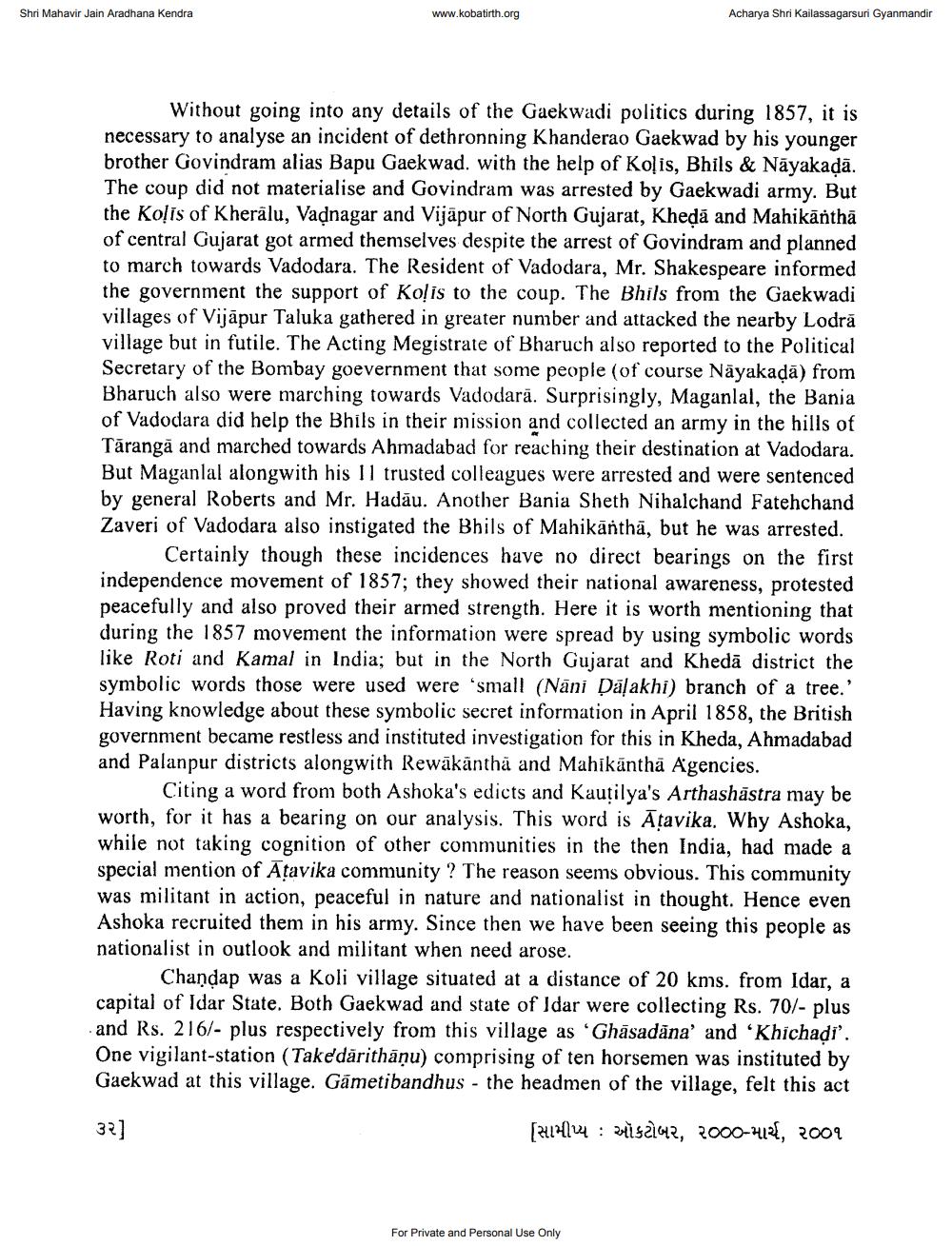________________
Shri Mahavir Jain Aradhana Kendra
www.kobatirth.org
Acharya Shri Kailassagarsuri Gyanmandir
Without going into any details of the Gaekwadi politics during 1857, it is necessary to analyse an incident of dethronning Khanderao Gaekwad by his younger brother Govindram alias Bapu Gaekwad. with the help of Koļis, Bhils & Nāyakaļā. The coup did not materialise and Govindram was arrested by Gaekwadi army. But the Kolis of Kherälu, Vadnagar and Vijāpur of North Gujarat, Kheda and Mahikānthā of central Gujarat got armed themselves despite the arrest of Govindram and planned to march towards Vadodara. The Resident of Vadodara, Mr. Shakespeare informed the government the support of Kolis to the coup. The Bhils from the Gaekwadi villages of Vijāpur Taluka gathered in greater number and attacked the nearby Lodrā village but in futile. The Acting Megistrate of Bharuch also reported to the Political Secretary of the Bombay goevernment that some people (of course Nāyakadā) from Bharuch also were marching towards Vadodarā. Surprisingly, Maganlal, the Bania of Vadodara did help the Bhils in their mission and collected an army in the hills of Tārangā and marched towards Ahmadabad for reaching their destination at Vadodara. But Maganlal alongwith his 11 trusted colleagues were arrested and were sentenced by general Roberts and Mr. Hadāu. Another Bania Sheth Nihalchand Fatehchand Zaveri of Vadodara also instigated the Bhils of Mahikanthā, but he was arrested.
Certainly though these incidences have no direct bearings on the first independence movement of 1857; they showed their national awareness, protested peacefully and also proved their armed strength. Here it is worth mentioning that during the 1857 movement the information were spread by using symbolic words like Roti and Kamal in India; but in the North Gujarat and Khedā district the symbolic words those were used were 'small (Nani Dāļakhi) branch of a tree.' Having knowledge about these symbolic secret information in April 1858, the British government became restless and instituted investigation for this in Kheda, Ahmadabad and Palanpur districts alongwith Rewākānthả and Mahikanthä Agencies.
Citing a word from both Ashoka's edicts and Kautilya's Arthashăstra may be worth, for it has a bearing on our analysis. This word is Ātavika. Why Ashoka, while not taking cognition of other communities in the then India, had made a special mention of Ātavika community ? The reason seems obvious. This community was militant in action, peaceful in nature and nationalist in thought. Hence even Ashoka recruited them in his army. Since then we have been seeing this people as nationalist in outlook and militant when need arose.
Chandap was a Koli village situated at a distance of 20 kms. from Idar, a capital of Idar State. Both Gaekwad and state of Idar were collecting Rs. 70/- plus and Rs. 216/- plus respectively from this village as 'Ghāsadāna' and 'Khichadi'. One vigilant-station (Take'därithāņu) comprising of ten horsemen was instituted by Gaekwad at this village. Gāmetibandhus - the headmen of the village, felt this act
32]
(4414: 2452142, 2000-443, 2009
For Private and Personal Use Only




